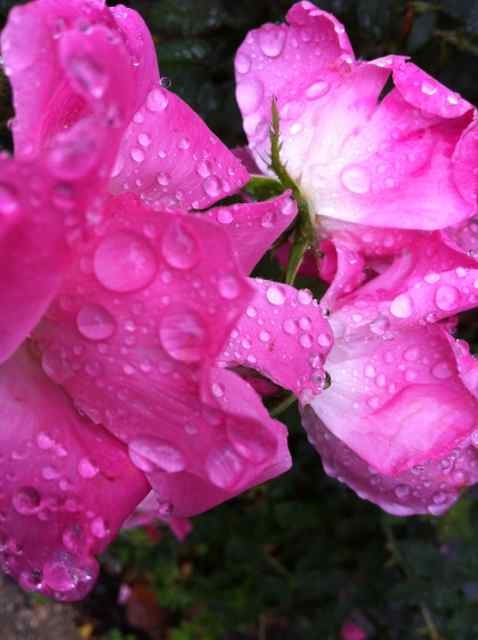

Howdy, pilgrim! No ads — you're in volume 0.9907 of the ^zhurnal (that's Russian for "journal") — see ZhurnalyWiki for a Wiki edition of individual items; see Zhurnal and Zhurnaly for quick clues as to what this is all about; see Random for a random page. Briefly, this is the diary of ^z = Mark Zimmermann ... previous volume = 0.9906 ... complete list at bottom of page ... send comments & suggestions to "z (at) his (dot) com" ... click on a title link to go to that item in the ZhurnalyWiki where you can edit or comment on it ... RSS

- Thursday, October 17, 2013 at 04:10:25 (EDT)
Friend LaNedra meets me at the elementary school near Paint Branch Trail. We follow the path down to Lake Artemesia and walk a lap, chatting about life, money, friends, and the threatened Federal Government shutdown. The Reward: a Marathon Deli dinner! Alas, I miscalculate the duration and parking tickets ensue — my fault, my responsibility. Runkeeper and Garmin record distance and pace.
- Wednesday, October 16, 2013 at 04:04:36 (EDT)
From the chapter "Seventh Week: Mindfulness in Thinking" of Andrew Weiss's Beginning Mindfulness:
There is a story about a Zen student who kept pestering his teacher to tell him the secret of awakening. After being asked so many times, the teacher finally got annoyed. He said to his student, "You know the space between your thoughts?" The student eagerly answered, "Yes, yes!!" The teacher said, "Well, make it larger!" ...
- Tuesday, October 15, 2013 at 04:08:50 (EDT)
A quarter moon near Jupiter peeks through scattered clouds at 0-dark-630 when I meet Sandra "Sam" Yerkes, Gayatri Datta, and Jennifer Weiland at Candy Cane City. A slow walk-jog with Gayatri, who is experimenting with a heart-rate monitor, warms us up. Then after 0730 faster trekking along Rock Creek begins with Ken Swab, Rebecca Rosenberg, Emaad Burki, and Barry Smith. Ken and Rebecca share stories of the Marathon du Medoc and other recent races. We pass through the midst of a strange underwear-over-clothes running event taking place near Military Road. Ken trips and falls at one point but not badly. Jennifer's mom is in town, this morning working on staining her cedar shed. Ken tells about visiting the Eiffel Tower and a huge sand dune in France. Near our return to Candy Cane a young cross-country crew sprints past and lures us to run faster. Runkeeper and Garmin concur on route and pace.
- Friday, October 11, 2013 at 07:02:58 (EDT)
Those who know the most, say the least.
Yes, and how many pages are there in the ZhurnalyWiki already? (^_^)
- Thursday, October 10, 2013 at 07:07:24 (EDT)
More a hike than a run: Wednesday evening walk and jog along the Paint Branch Trail in rapidly deepening darkness, chatting on the phone with friend Rayna Matsuno and trying to avoid speedy cyclists near the University of Maryland campus. Turn back before entering Lake Artemesia to avoid being locked in if the fence is closed while inside. In the other direction, turn back at the dog park near Metzerott Rd and dash the last half mile back to the parking lot near the Route 1 underpass. Runkeeper shows splits as 14.5 + 16 + 10.1 minutes each; Garmin GPS generally agrees.
- Wednesday, October 09, 2013 at 04:08:25 (EDT)
From Day 53 of Rolf Gates and Katrina Kenison's book Meditations from the Mat:
Forgiveness can never be entirely self-serving. We do forgive others for our own spiritual growth, but the most important reason for forgiveness is our belief in interconnectedness. Because we are all one, what we cannot forgive in others we cannot forgive in ourselves; what we withhold from others we withhold from ourselves. The judgments we pronounce upon others are ultimately being pronounced upon ourselves, because there is no you and no me, there is only we. Forgiveness, therefore, is an act of self-ove, and by loving ourselves we love the whole of humanity. Ensnared in our own condemnation, we can find no peace. Forgiveness frees us from this predicament and lays the foundations upon which our spiritual life can be built.
(cf. This Is Water (2009-05-21), Core Buddhism (2011-10-17), Inner Iguana (2013-07-05), Ground of Being (2013-10-03), ...)
- Tuesday, October 08, 2013 at 04:16:07 (EDT)
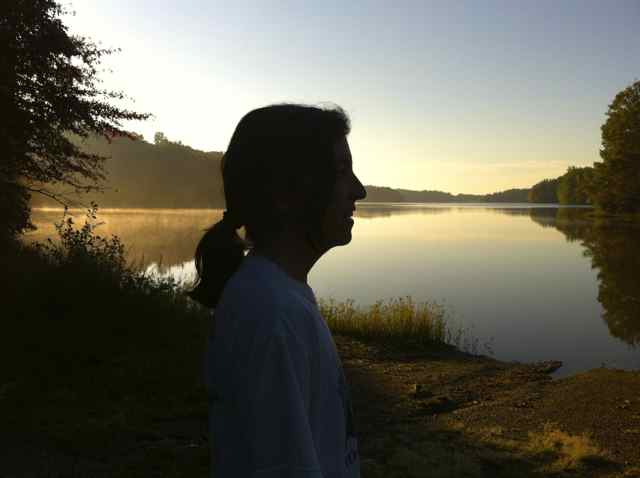 | "If I weren't with you, I would give chase. What a great ponytail!" I tell comrade Kate Abbott after a young lady blasts past us at our mile ~12. "Hmmmm," Kate observes gently, "maybe your eyes are drifting a bit lower than the PONYtail, to, uh, ...?" I deny it, we laugh together, and I confess to past instances of going too fast in similar foolish past pursuits. The girl pauses to stretch, then races by us again. We see her a couple of times later, when she reverses course to run the opposite way from us. It's a lovely Sunday morning for four Burke Lake loops with Kate. We talk and trek with early morning mist on the water, sunbeams slanting through the trees, a giant spiderweb above the trail, a great blue heron wading near the far shore, and cyclists, joggers, dog-walkers, pram-pushers, hikers, and flocks of buff young cross-country runners. Our first two laps clockwise, last two CCW. Although temperatures are in the ~60°F area when we start at 8am, they rise as the sunny morning progresses. Yesterday's evening rain has left puddles on the trail and high humidity in the air. We're both overheating a bit after the first ~4.6 mile loop, and Kate takes off her short-sleeved shirt and lends it to me, to replace the long-sleeved one I was wearing. Coke Zero from Kate's cooler helps us rehydrate. We both begin to stumble more as the miles flow by. In the final stretch Kate trips on something, perhaps a hidden root, and almost falls, but catches my arm and recovers. When I ask Kate about what I can do to improve myself, she responds with something that's much like the great quote from Joe vs. the Volcano by Ossie Davis's character Marshall, the limo driver who takes Joe to get a good suit: "Clothes make the man. I believe that. You say to me you want to go shopping, you want to buy clothes, but you don't know what kind. You leave that hanging in the air, like I'm going to fill in the blank, that to me is like asking me who you are, and I don't know who you are, I don't want to know. It's taken me my whole life to find out who I am, and I'm tired now, you hear what I'm saying?" |
- Monday, October 07, 2013 at 04:00:26 (EDT)
In late August an anonymous genius posted on the Oddmuse Wiki a much-improved way to capture tidbits from web pages with a single click, which my 2012 initial-version Wiki Scrapbook Bookmarklet did via a complex method that required a server-side module. The new approach uses the "Comments_on" feature of Oddmuse. To begin, simply:
To use it, when browsing a web page just highlight a section of interesting text (up to a few paragraphs), then click on the bookmarklet. The URL, page title, and highlighted selection will be appended to the target page of the bookmarklet. (Note that for this process to work on ZhurnalyWiki you likely will need already to have accepted a cookie that permits editing. See page Editor Password for instructions on how to do that, if you aren't a spammer.)
javascript:void((function() {
var wikiBase = 'http://zhurnaly.com/cgi-bin/wiki';
var scrapPage = 'SandBox';
var urlOfWebPage = document.location;
var titleOfWebPage = document.title;
var linkToWebPage = '[' + urlOfWebPage + ' ' + titleOfWebPage + ']';
var selectedText = window.getSelection();
var capturedText = linkToWebPage + '\n\n' + selectedText;
var nw = window.open('','','toolbar=0,resizable=1,scrollbars=1,status=1,width=750,height=500');
var nwd = nw.document;
nwd.body.innerHTML =
'<div class="comment">' +
' <form method="post" action="http://localhost/cgi-bin/wiki.pl/Public" enctype="multipart/form-data" accept-charset="utf-8" class="comment">' +
' <p>' +
' <label for="title">Title:</label>' +
' <input name="title" id="title">' + '<br/>' +
' <textarea name="aftertext" rows="10" cols="78" id="aftertext">' +
' </textarea>' +
' </p>' +
' <p>' +
' <span class="username">' +
' <label for="username">Username:</label>' +
' <input name="username" size="20" maxlength="50" id="username" type="text">' +
' </span>' + '<br/>' +
' <span class="homepage">' +
' <label for="homepage">Homepage URL:</label>' +
' <input name="homepage" size="40" maxlength="100" id="homepage" type="text">' +
' </span>' +
' </p>' +
' <p>' +
' <input name="Save" value="Save" accesskey="s" type="submit">' +
' <input name="Preview" value="Preview" accesskey="p" type="submit">' +
' </p>' +
' </form>' +
'</div>';
nwd.getElementById('title').setAttribute('value', scrapPage);
nwd.getElementById('aftertext').value = capturedText;
var f = nwd.forms[0];
f.setAttribute('action', wikiBase);
f.submit();
})())
Brilliant — many thanks to whoever created this neat hack!
(cf. Scrapbook Bookmarklet Version 0.1 (2010-12-26), Wiki Scrapbook Bookmarklet (2012-01-11), ...)
- Sunday, October 06, 2013 at 11:01:13 (EDT)
Excuses: tight left hamstring, ran already this morning, slight sniffles, Marathon Deli closes in an hour, etc., etc. — so stop with a guilty conscience after only five 400m repeats (1:42 + 1:39 + 1:41 + 1:43+ 1:45) and a limping trot to accompany DS Robin on part of his final lap, as a nearly-full moon rises over the University of Maryland track. Runkeeper and Garmin concur in the oval path.
- Saturday, October 05, 2013 at 11:41:45 (EDT)
Pre-dawn with Kristin Heckman around the MITRE/McLean neighborhood: Orion, Sirius, and Jupiter glimmer through the gaps between streetlights. We chat about family, friends, training, soreness, and life. Runkeeper and Garmin concur on the distance and pace.
- Friday, October 04, 2013 at 04:16:33 (EDT)
Thoughts on Oneness, from the chapter "Eighth Week: Mindfulness in Objects of Mind" of Andrew Weiss's Beginning Mindfulness:
... When we truly experience non-self and impermanence, our illusion of being separate falls away and we contact the ground of being from which all things arise and pass away. In the "I/you" world in which we live we encounter the reality of nonduality when we truly experience that we cannot separate ourselves as the perceivers from what we perceive or ourselves as the thinkers from what we are thinking. The personal identification slips away; the fear is at once "my" fear and, simply, fear, part of the common ground of being. In this nondualistic world, the world of mindfulness, there is no "I/my/me," no labeling, no personalizing. Once this door is open, we can simply be present in mindfulness, aware of what is going on, and even for brief moments, as we experience the nonduality inside our dualistic world, not even being aware that we are aware. In Zen, this experience of mindfulness is expressed: "In the seeing, only what is seen. In the hearing, only what is heard. In the touching, only what is touched. In the feeling, only what is felt. In the thinking, only what is thought."
When we "get" the reality of all this in our being, we encounter life as it is. I have noticed that those who truly have lived this awareness, even if only for a moment, soften a bit around the edges. In my own life, my experience of this has helped me open my heart and be more loving, kind, understanding, and compassionate. For me, it is very simple: Everything makes up me, I am part of everything. I am the result of causes and conditions that I and countless others create, and I create causes and conditions for myself and countless others. I know that all things change when causes and conditions change, and that brings up the desire to make as many as I can of these causes and conditions ones that promote peace and love. To manifest this in my daily life, I must cultivate the space and activity of mindfulness, where the words, and my own personal narrative, drop away. This lies deep at the heart of the Buddha's teachings on mindfulness. Here we can touch life directly, outside of notions, concepts, and beliefs. Here we can embrace the heart of the cosmos.
(cf. This Is Water (2009-05-21), Core Buddhism (2011-10-17), Zen Training (2011-10-29), Mirroring Each Other (2013-05-12), Opening to Love (2013-09-27), ...)
- Thursday, October 03, 2013 at 04:19:25 (EDT)
Another fun early morning run with colleagues Amber Sprenger, David Foster, Kerry Buckley, and Kristin Heckman: David did an Olympic triathlon 9 days ago and leads us around the neighborhood (one rabbit sighted), then sets off for bonus mileage after the rest of us stop; Amber's young son is recovering from a broken arm; Kristin is surviving on only a few hours of sleep; Kerry is happy and fast! Runkeeper measures the distance.
- Wednesday, October 02, 2013 at 04:10:27 (EDT)
"30 Things to Start Doing for Yourself" by Marc Chernoff is a glittery list of positive admonitions that DS Merle forwarded some months ago. It's hyper-optimistic and hard to argue with — but also frustratingly redundant. Minus the cheery explanations of each item, the list suggests:
All quite splendid, of course. But wouldn't it be better to sort and arrange and structure them into fewer, more orthogonal and independent dimensions? What are the key virtues to really strive for in life? Perhaps they include:
And can these be further compressed, unified, or otherwise structured as aspects of The Good? Hmmmm ...
(cf. My Religion (2000-11-06), The Meaning of Life (2008-07-24), Core Buddhism (2011-11-17), ...)
- Tuesday, October 01, 2013 at 05:13:47 (EDT)
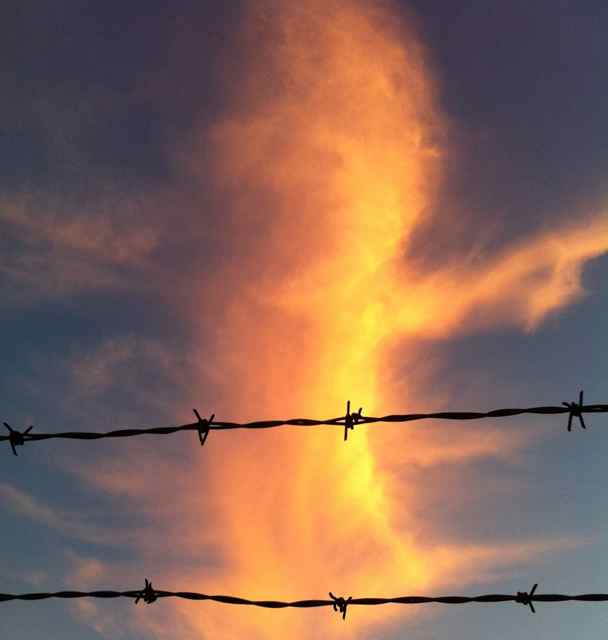 | "It's all over except the crying!" Maura deMouy offers a new mantra for the final fast segment of a long run. We meet at KenGar where Barry Smith & Rebecca Rosenberg & I are setting off for half a dozen miles along Rock Creek Trail. Maura joins us as we hear of Rebecca's Marathon du Medoc last weekend. For the last stretch Maura and I pull each other along at near-race pace — whee! Then she heads off to pick up her young sons, Rebecca decides to do a few more miles, and Barry gives me a ride home via Donut King. Backstory: I leave home at 6:15am; jog via Kensington, startling two rabbits in a front yard; take a detour when it seems I'm ahead of schedule; pause to photograph luminous sunrise-painted cirrus clouds behind barbed wire fencing; still arrive early, so proceed upstream (Barry overslept and texts that he is coming later); answer Gayatri Datta's phone call and turn back to meet her; run a few miles with Gayatri, then join Barry for a couple of hill repeats, pulled along by a passing freight train. |
- Monday, September 30, 2013 at 04:12:03 (EDT)
Sight from the Metro train at 0542 one morning some months ago, a brightly glowing neon sign that read:
| POP YES |
An admonition from one of my kids reminding me to say, "Yes, and..." to everything? Hmmmm, maybe that would be a good thing. But after a quick doubletake, I realize it's just a Popeyes fried chicken restaurant with the first "e" burned out. Shades of Mark Center ...
- Sunday, September 29, 2013 at 19:15:34 (EDT)
Lovely-cool weather for a trek along Rock Creek. Spy: a dozen deer, including one buck with a great rack eating flowers from a neighbor's garden. Middle miles flow with comrades Gayatri Datta and Barry Smith. Runkeeper roughly agrees with Garmin GPS, which has splits as 10:45 + 9:47 + 11:27 + 12:58 + 10:58 + 16:12 + 11:14 + 11:58 + 12:56 + 11:14 + 11:55 + 15:19 + 10:46 + 11:29 + 11:01 + 11:30 + 9:16 + and a final fraction at ~9:10 min/mi pace.
- Saturday, September 28, 2013 at 04:49:48 (EDT)
In Chapter 10 ("Cultivating the Qualities of Loving-Kindness and Compassion") of Phillip Moffitt's book Emotional Chaos to Clarity, the section "Opening to Love" wrestles with questions of what love really is:
Loving-kindness and compassion meditation are transformational when practiced over several years. They become established mind states such that you spontaneously respond to all situations with one or the other or both. When you reach this stage of development, you realize not only that you are capable of experiencing such beautiful mind states but also that when your mind is free of greed, aversion, and delusion it automatically generates these mind states.
As your capacity for compassion and loving-kindness grows, you also begin to discover the many nuances of love. Is love the same as desire? Is it love you are feeling when you wish good things for your loved ones? Or is love an unmoving energetic state from which all else moves, including your good intentions and good wishes? If it is the latter, then there is an unchanging state of love that we are sometimes in touch with and other times not. When you are in touch with this unchanging state, feelings of compassion and loving-kindness spontaneously arise in your. You value these responses so much because they allow you to temporarily become part of this unchanging state of love. From this perspective, love is always present. It is we who are separated from this love due to our inability to simply be with things as they are. As you begin to stay more present, to fully receive the moment just as it is, you experience move loving intentions — even toward difficult people — because you feel less separation.
Interesting speculations. Does the image of love as an unmoving center, at least metaphorically, suggest how nonattachment can still flow toward love rather than just into a null state of emptiness? Maybe the key to giving direction to mindfulness and nonattachment is the third leg of the core buddhism stool, oneness?
In the same section Moffitt confesses his own early feelings toward deliberately cultivating love, and how those feelings evolved:
When I was first introduced to loving-kindness and compassion practices, during a ten-day silent meditation retreat more than twenty years ago, my reaction was to walk out of the room each time they were taught. I was interested in deepening my understanding of the mind, and when the teachers started discussing developing emotional qualities, I thought they were being sentimental. I was convince one could not practice compassion as a discipline, and the idea of fostering loving-kindness through repetition of certain phrases seemed silly. Moreover, since mindfulness practice involves not controlling the mind but learning to stay present with it wherever it moves, I thought what the teachers were asking us to do would interrupt the momentum of the practice. I was really irritated by the whole idea and felt resentment and distrust. I skipped the sittings in which these practices were taught and used the time to run on a nearby track, feeling simultaneously defiant and a bit guilty. After a few days of rebellion, it occurred to me that maybe I should have some actual experience of the practices if I was going to have such animosity toward them. So I started taking the instruction and, once I stopped feeling self-conscious, discovered that they had real value. The practices involve deepening compassion and loving-kindness for yourself, your benefactors, those you are close to, and those for whom you have neutral or even negative feelings. I was amazed that they really worked.
Anecdotal, so symbolic, fascinating — and possibly important as well as useful?
(cf. Steadiness of Heart (2011-11-17), Softening into Experience (2012-20-12), Emotional Chaos to Clarity (2013-07-06), Expectations vs. Possibilities (2013-08-13), ...)
- Friday, September 27, 2013 at 04:45:03 (EDT)
Some years ago, running buddy Cara Marie Manlandro tells me that we need to tack a couple of extra miles on to the end of the day's long run, to reach her weekly goal.
"Sure, CM," I reply, "but why don't we do the extra miles at the start, when we're fresh?"
- Thursday, September 26, 2013 at 04:19:59 (EDT)
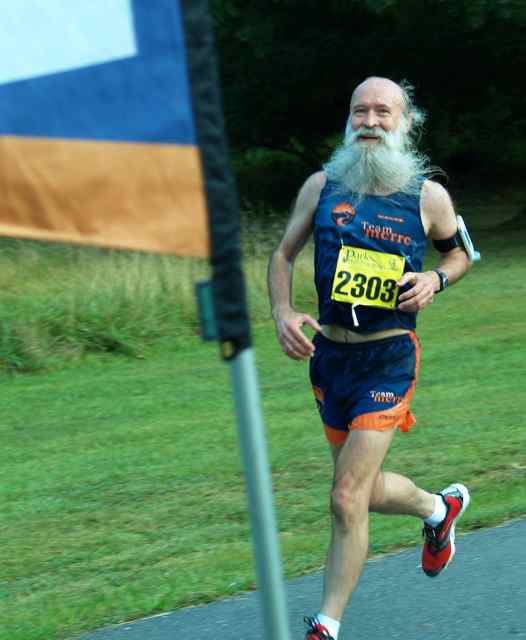 | Splits, from my watch based on the mile markers: 7.3 + 7.5 + 8.5 + 8.2 + 8.1 + 8.4 + 8.3 + 8.2 + 8.1 + 8.2 + 8.3 + 8.4 + 8.2 and 0.9 min final fraction. Official result: overall 434th place, 6th of 42 in the male 60-64 year cohort, chip time 1:46:39, gun time 1:50:13 (starting in the third wave), average pace 8:09 min/mi. Total finishers: 1141 women (96 of them ahead of me) and 1145 men (337 ahead of me). Runkeeper has the trackfile for the run, based on the iPhone GPS. | 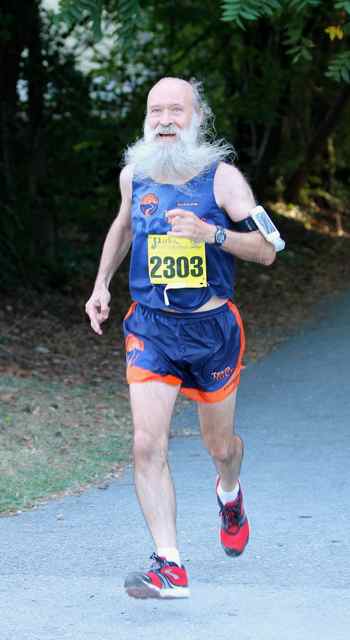 |
(cf. 2008-09-14 - Parks Half Marathon Plus, 2009-09-13 - Double Parks Half Marathon, 2010-09-12 - Parks Half Marathon Plus, 2011-09-11 - Parks Half Marathon, ...)
- Wednesday, September 25, 2013 at 04:35:06 (EDT)
In "How to Write the Perfect Bug Report" Dan Loewenherz begins by telling a story:
You woke up this morning to a nice cup of coffee, opened up your application to get work done ... and you can't login.
First thing, DON'T PANIC. It's easy to feel helpless if you're not the developer, since you may think there's not much you can do.
Wrong! Your role is super important. You speak for the users. The better you do this, the quicker the issue will get fixed and the happier everyone will be. So if you find that you're stressed, just take a deep breath.
...
Brilliant advice, especially the reminder to remain calm, breathe, and "speak for the users" (an allusion to the movie Tron). It's also reminiscent of some of the best rules for bug reporting (and reporting almost anything else!) from the ancient (1980s) "Understanding Bug Reporting" guide in the GNU Emacs manual:
The most important principle in reporting a bug is to report facts. Hypotheses and verbal descriptions are no substitute for the detailed raw data. Reporting the facts is straightforward, but many people strain to posit explanations and report them instead of the facts. If the explanations are based on guesses about how Emacs is implemented, they will be useless; meanwhile, lacking the facts, we will have no real information about the bug. If you want to actually debug the problem, and report explanations that are more than guesses, that is useful—but please include the raw facts as well.
As in the TV detective show Dragnet: "All we want are the facts."
(cf. ParaMode (2000-05-09), PureTheory (2001-08-04), PickyAboutFacts (2003-03-11), ...)
- Tuesday, September 24, 2013 at 04:30:46 (EDT)
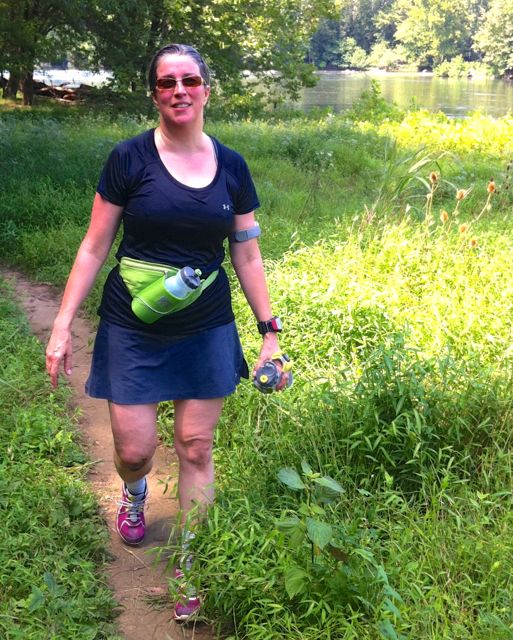 | "Do NOT let me stop running!" Mary Ewell sternly instructs me as we prepare for the final segment of our hyper-humid Labor Day afternoon run-walk along the Potomac near Riverbend Park. A tiny lizard scampers across our path as we begin the upstream trek; a couple of hikers point out an even tinier snake on our way back. Raindrops sprinkle the fern leaves all-too-briefly midway. The park snack bar provides sugary-soda rehydration. We each carry two water bottles and debate who is more totally sweat-soaked when we stop. Garmin GPS and Runkeeper iPhone concur on our distance and pace. | 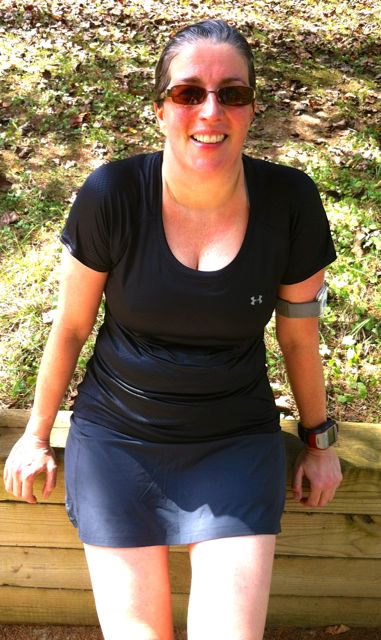 |
- Monday, September 23, 2013 at 04:05:33 (EDT)
Another used-book-sale gem: Andrew Weiss's Beginning Mindfulness. It captivates on the second page of the Introduction with, "... the best idea about life is no idea at all." Similarly, at the end of that foreword comes the enchanting advice, "If, after all this introduction, you have an idea of what mindfulness meditation practice is, I encourage you to throw it out the window as the first step on your true path to mindfulness. The Buddha used to say that the teachings of mindfulness are a raft that takes us over the waters from the shore of delusion to the shore of awakening. It would be silly, he reminds us, to worship the raft or to carry it around on dry land."
Then, the encouraging words, "Remember: Go Slowly, Breathe, and Smile!"
What's not to like with that launching pad? So disobey instructions as usual, open the book randomly, and near the end of the chapter for the Fourth Week discover the utterly enchanting:
And now for a surprise:
In four short weeks, you have learned the very basics of mindfulness practice: how to become aware of your breathing, how to follow your breathing and your actions in everyday life, how to become aware of thoughts and feelings when they arise and how to stay present with them, and how to challenge and begin the process of letting go of your most cherished assumptions about yourself and the world. You now have all the basic tools you need to make mindfulness practice the ground of your life.
If you simply practice mindfulness when you are sitting, walking, standing, lying down, eating, cooking, driving, or doing anything else in your life, your life will change. Living with awareness of what you do and the consequences of your actions will alter your life and your relationships with others. If you follow the practice of asking "Who am I?" and "What is this?" about everything and everyone you encounter, even about every thought and feeling you have — in other words, if you go through life without making any assumptions and simply encounter things as they are — your life will change dramatically. When you live with the awareness that questions are more important than answers, that encountering things as they are is more beneficial than just accepting your old stories about them, a huge burden falls by the wayside and you transform your life.
These practices require meticulous attention. They ask us to pay compete attention to what is happening right now, no more or less. They ask that we live in present time without distraction. They will not allow us to settle for what we already know. Are you ready to change your life?
There is much more to learn and experience. In the next section, we begin to explore the world of our own beings in more detail. We begin to cultivate our awareness of body, feelings and sensations, thinking, and the objects of our mind's focus and attention. So if you think you've reached the end, that's just what you think. The reality is different. Let's go on.
Wow!
(cf. ChangeYourLife (2002-09-25), HowGreatThouArt (2005-03-16), Present-Moment Reality (2008-11-05), Being with Your Breath (2010-02-20), Breath and Awareness (2011-03-12), Beginner's Guide to Insight Meditation (2011-08-05), Core Buddhism (2011-10-17), It's Not What You're Thinking (2013-08-17), ...)
- Sunday, September 22, 2013 at 04:51:42 (EDT)
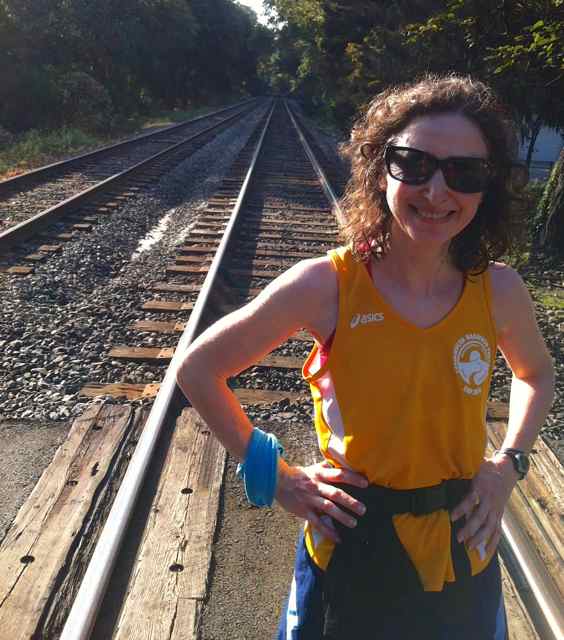 | "Have you heard people using the word 'Ask' as a noun? That drives me crazy!" Rebecca Rosenberg says as we trek along the Bethesda Trolley Trail. We discuss linguistic back-formation (which I mistakenly call "back-construction"), neologisms, and Shakespeare's vocabulary. Rebecca confesses to coining "Funge" with reference to using something fungible; I approve. We concur on the misuse of apostrophes and the loss of the good/well and who/whom distinctions. It's a warm and humid Sunday morning. Rebecca will be doing the Marathon du Medoc in northern France next weekend. She tells of a 20 page detailed information packet that the race organizers sent her — entirely in French! As we return to her neighborhood via Rock Creek Trail, Rebecca spies multiple rabbits and deer. Flocks of other runners greet her by name. "We're not TOO obsessive!" we agree, as we zig-zag to make both GPS units exceed 9 miles. At the Garrett Park train station we pause for a photo op: RR crossing! Runkeeper and Garmin GPS roughly agree on distance and splits. |
- Friday, September 20, 2013 at 04:07:00 (EDT)
From the movie Argo, about carrying on, even in tough circumstances:
"There are only bad options. It's about finding the best one."
"You don't have a better bad idea than this?"
"This is the best bad idea we have, sir. By far."
(cf. OptimistCreed (1999-04-16), Suboptimism (2008-05-26), ...)
- Thursday, September 19, 2013 at 05:30:02 (EDT)
^z and Father (Werner Edward Zimmermann)
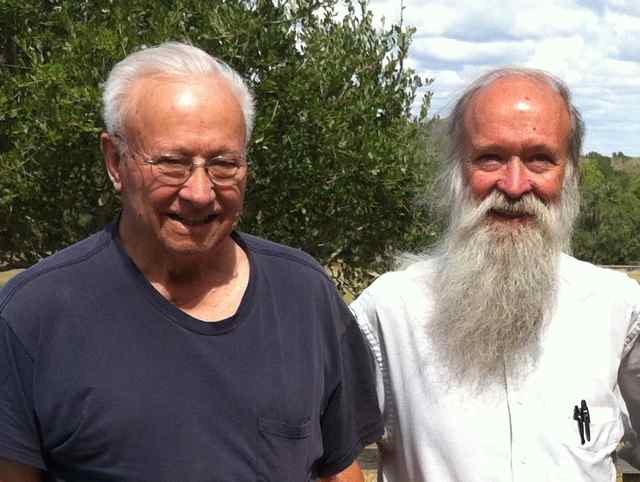
- Wednesday, September 18, 2013 at 04:14:15 (EDT)
In "Ending Up", his penultimate column in The American Scholar a few years ago, local author-essayist Michael Dirda writes scathingly about illiterate modern politicians:
... Gladstone, England's most famous 19th-century prime minister, built a personal library of more 32,000 volumes and it was for use, not ostentation. His rival Disraeli, when out of power, brought out excellent and witty novels. At best our leading politicians may occasionally open a book if shown how. ...
and engagingly about his own addiction to reading. In a used-book store he opens a collection of Flaubert's novels at random:
... and my eyes lit on my favorite passage from The Temptation of St. Anthony, the section where the Queen of Sheba appears to the austere saint to tempt him with the delights of her body. Her enticements rise to a climax with the words: "Je ne suis pas une femme, je suis un monde." And it was just those words I opened to: "I am not a woman, I am a world." ...
So of course he had to buy it!
(cf. RadRobReMichaelDirda (2002-10-31), ReadingAtRisk (2004-09-01), ...)
- Tuesday, September 17, 2013 at 04:37:41 (EDT)
 | "Have I explained the Sea Breeze phenomenon yet?" I ask Kate Abbott, as the wind picks up when we run along the Potomac near National Airport. "Yes! Many times!" is Kate's instant answer. I've just finished lectures on Scoring Rules for probabilistic predictions, and Contract Bridge bidding systems. Today's run reverses the loop we did a fortnight ago: from East Falls Church Metro down the W&OD, Custis, Mount Vernon, and Four Mile Run trails. Heat & humidity wear us down, but a pause at the Shirlington "Weenie Beanie" for jumbo sodas makes the final miles tolerable. Best passing-bike warning comes from a babbling baby in the jumpseat. Rabbits and a chipmunk scamper close to us. A cyclist heading the opposite way says, "Hi Mark!" but Kate and I don't recognize her. A few days later, when by chance I send an electronic "GM!" to a colleague, she replies, "You were out early Saturday!" — and it turns out that Beth S. was the one on the bike, near the beginning of her own 30 mile excursion. Small world! Jupiter glitters by the crescent moon as we set off ~6am. The morning sun is shining like a red rubber ball — and guess what song gets stuck in my head for miles 2-12? We pause at a park on the Potomac to take photos of the scaffolding-clad Washington Monument and Lincoln Memorial across the water, and one of mine, with Kate in silhouette, turns out quite nicely after a little post-processing to crop, straighten, and adjust contrast and saturation. Garmin GPS and Runkeeper concur on distance and splits. |
- Monday, September 16, 2013 at 04:07:22 (EDT)
From last year, a lovely thoughtful essay by Rayna Matsuno Weise, titled "The Importance of Having a Teacher", on the value — especially in times of stress and crisis — of setting aside time for oneself and of doing a regular practice of mindfulness:
My partner is also my teacher. As such, we typically avoid any discussion of my practice in the home, but tonight it came up. Like many, I am attached to the practice — or rather, asana. In the heat of feeling sorry for myself, I began to lament that over the past five years of practicing, I've made little growth. My partner stopped me in my tracks and corrected my limited definition of "the practice." But being the stubborn person that I am, I still needed to get everything off of my chest.
"I've always moved forward then backward, forward then backward."
All sorts of challenges — pregnancy, parenthood, finishing a Ph.D., losing a parent, recovering from a serious illness, moving across the Pacific Ocean (twice), big changes in my professional career — all of these have tempered any forward movement in my asana practice. When I took a breath between rambling my list of woes, my partner simply said, "And this is why your practice has grown so much."
I stopped to reflect.
What this practice has done for me over the years is it has given me the quiet that I needed — a centerline through the "zig-zagging" that is life. The daily routine, the discipline — there's comfort in knowing that at least something is the same every day. In its ideal form, this is a practice of sameness: six days a week, same time, same shala, same teacher, same asanas, matching inhale and exhale.... While every other aspect of our lives may be in disarray, the practice is a reliable constant.
A particular memory comes to mind as I write this. The morning my father passed away, I followed the usual routine of dropping my son off at daycare and making my way to the shala. Upon sharing the news with my partner, he told me, "Just practice primary today." The next morning, I thought I would again have some kind of "reprieve," but instead my partner said, "Do your usual practice." It was a major effort just being there on my mat, let alone exerting myself to my (perceived) physical and mental limits. But as I struggled to maintain my focus through feelings of sadness, I started to realize what an amazing teacher I have. There was great comfort in the sameness. My world as a daughter may have felt shattered, but for those two hours of my practice, nothing had changed. My teacher had given me the ultimate solace.
Whatever my external, physical practice may be now or become in the future, it will always be my own, where I find stillness. And I am grateful for my teacher, and my past teachers, for sharing this practice with me. As my teacher always reminds people, "It's the method, not me." But, without our teacher, there is no medium for which the practice to pass through.
Vande gurunam.
(cf. SpasmodicHercules (2007-05-01), This Is It (2008-11-14), Without Effort, Analysis, or Expectation (2010-08-04), Expect Nothing (2012-02-20), Mindfulness As a Love Affair (2013-08-10), ...)
- Sunday, September 15, 2013 at 05:33:13 (EDT)
| Convex curves catch my eye as I pass an iconic Austin water tower near mile 4.5 of this morning's neighborhood trek. First miles go fast, but then the rising sun starts to sauté my skull and slow the pace. A couple of mid-course diversions lead finally to a water fountain in a roadside park. Finally, clouds move in to shade-enable a few bonus miles at speed around the LBJ High School campus. |  |
- Saturday, September 14, 2013 at 05:12:27 (EDT)
In the spirit of Ernest Hemingway's purported Six Word Story — "For sale: baby shoes, never worn." — at MITRE some months ago an online discussion invited readers to submit a six word job description. Many were forgettable. One, by digital media specialist Michael Baker, jumped out:
| Ideas have dimensions, I move camera. |
What a great metaphor!
- Friday, September 13, 2013 at 04:39:13 (EDT)
In Margaret Foster's recent analysis/discussion of "College's Raison d'être" in The American Scholar [1], a thoughtful comment about the value of learning to think:
"Good professional training must include the kind of intellectual scope and imaginative flexibility that one develops only through liberal learning," said Brennan O'Donnell, president of Manhattan College. "I've heard many times from graduates of our school of engineering (all of whom take required liberal arts courses) some version of the following: 'My engineering courses got me my job; my arts courses got me my promotions.'"
(cf. SkillsOfDeliberation (2006-03-23), Full Realization (2013-05-04), ...)
- Thursday, September 12, 2013 at 04:20:57 (EDT)
| Soggy Summer Sunrise Speedwork: at LBJ High School track, a ladder of laps 1-2-3-4-3-2-1 with half-lap recovery walk between each interval. Yesterday's dinner of primary color TexMex food may have been slightly suboptimal (photo is a guacamole & queso tortilla cup) Splits during the ladder are 1:52 + 3:45 + 5:52 + 7:51 + 5:49 + 3:53 + 1:44. Infield sprinklers suddenly pop up like black mushrooms and welcome-surprise-spray me halfway through the pattern. A Texas-sized dragonfly buzzes by. On the way home, a tiny chihuahua dashes across the street and chases me, barking furiously. | 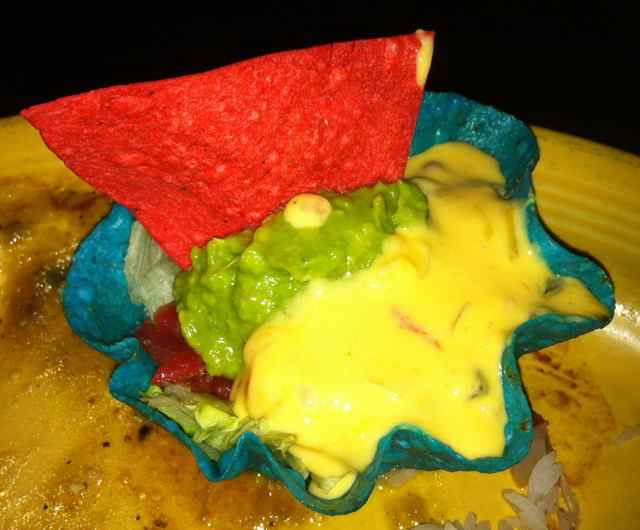 |
- Wednesday, September 11, 2013 at 04:12:50 (EDT)
A Chinese fortune cookie received at Pei Wei's in Austin Texas:
| The pleasure of what we enjoy is lost by wanting more |
(cf. Insight Meditation for Letting Go (2011-08-16), Patience (2013-03-03), Groundhog Day (2013-06-19), Expectations vs. Possibilities (2013-08-13), ...)
- Tuesday, September 10, 2013 at 04:17:29 (EDT)
 | Mad dogs, Englishmen, and Texans? I land in Austin to visit family and begin with a noonday run about the old 'hood — including an impossibly-fast 50 second lap around the track at my alma mater Pearce Jt High — apparently not everything is bigger in Texas! (perhaps it's only ~200m?) Temps are in the low 90's and the first half of the trek at ~10 min/mi degrades into a second half at 12+ pace. A kind gentleman watering his lawn refills my bottle from one of his four (!) garden hoses. When I get back to my Mom's house I discover that her kitty, Delilah has torn into a bag of catnip (sent by my brother) that I had hidden, apparently not well enough, in my backpack. Naughty Deli!! |
- Monday, September 09, 2013 at 04:16:01 (EDT)
Neighborhood loops with Amber Sprenger, David Foster, Ed Brown, and Kristen Heckman — one rabbit sighting on this warm and humid morning, with distance and pace from Runkeeper.
- Monday, September 09, 2013 at 04:13:17 (EDT)
A March 1955 photo of ^z and brother Keith, ages respectively 2.5 and 0.5 years:
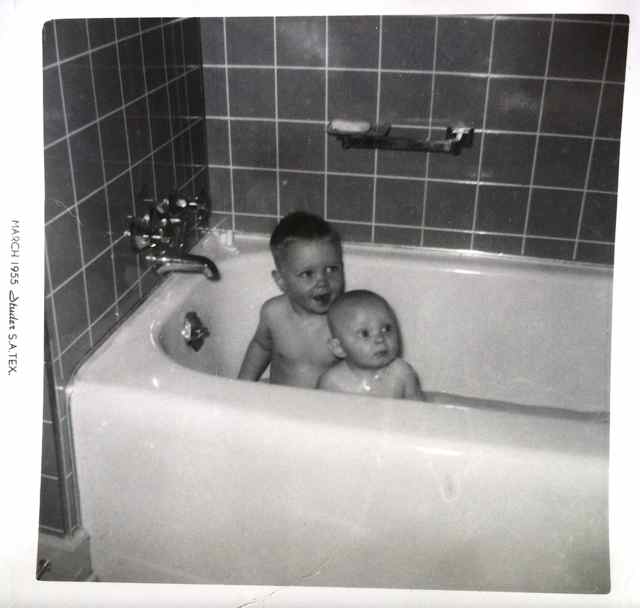
- Sunday, September 08, 2013 at 04:11:52 (EDT)
In Samuel R. Delany's sf novel Nova there's an arch exchange between a couple of the characters, Mouse and Katin, that expresses a sensible attitude toward tarot cards:
The Mouse dared half the distance of the rug. "You're really going to try and tell the future with cards? That's silly. That's superstitious!"
"No it's not, Mouse," Katin countered. "One would think that you of all people—"
The Mouse waved his hand and barked hoarse laughter. "You, Katin, and them cards. That's something!"
"Mouse, the cards don't actually predict anything. They simply propagate an educated commentary on present situations—"
"Cards aren't educated! They're metal and plastic. They don't know—"
"Mouse, the seventy-eight cards of the Tarot present symbols and mythological images that have recurred and reverberated through forty-five centuries of human history. Someone who understands these symbols can construct a dialogue about a given situation. There's nothing superstitious about it. The Book of Changes, even Chaldean Astrology only become superstitious when they are abused, employed to direct rather than guide and suggest."
The Mouse made that sound again.
"Really, Mouse! It's perfectly logical; you talk like somebody living a thousand years ago."
(The story of Nova is set ~1,150 years in the future.)
- Saturday, September 07, 2013 at 12:15:03 (EDT)
| "We're not obsessive!" I reassure Kate Abbott, as I insist on running until the most conservative of the three GPS units we carry exceeds 20 miles. Today is a new loop: W&OD Trail from East Falls Church to its Mile Zero origin, then Four Mile Run Trail to National Airport, Mount Vernon Trail to Rosslyn, and Custis Trail back to the W&OD and then our start. Sporadic rain keeps us cool, if soggy. Kate and I meet at the East Falls Church Metro in the drizzle at at dawn. We climb the stairs to near mile marker 5 of the W&OD Trail, a location we ran by last weekend (see 2013-08-11 - W-and-OD Trail with Kate). Kate cautions me not to slip and fall on the damp wooden bridges — when I stumble over a curb a few yards after we start, she reminds me of the fall I took at the beginning of our run long ago along the Potomac Heritage Trail (see 2009-01-19 - PHT Valkyrie). OK, Ma'am! |  |
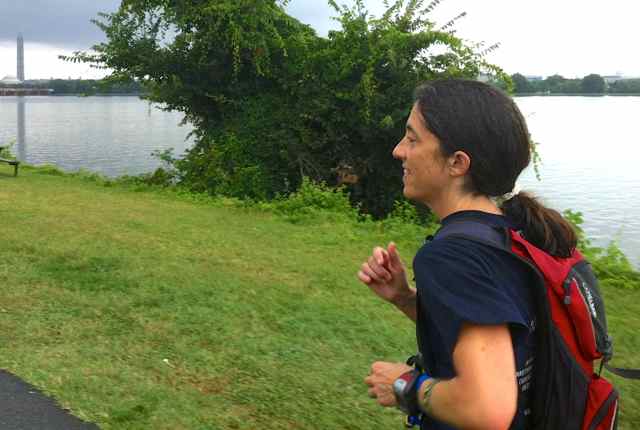 | For the first hour the trail is relatively empty. We pass the Custis Trail junction before W&OD milepost 4 but decide to go onward rather than branch off. I remember segments of the route here from the Andiamo race (see 2008-10-04 - Andiamo 2008, 2009-10-10 - Andiamo 2009, 2010-10-09 - Andiamo 2010). We pass an abandoned hand-cart tipped over under a bridge. I recall the ocular migraine blind-spot problems that I experienced entering some underpasses during runs here years ago. We reach Mile Zero of the W&OD and pause to pose for forgettable pictures in front of the sign. Kate spies arrows leading to the Four Mile Run Trail across the street, and we proceed on eastward. The stream next to us is rocky-pretty, then widens into the tidal Potomac. Water treatment and "foam" plants are next to the pathway. An underpass creates a contrasting edge-effect between drizzle and dry. We stop again to take photos. Other runners meet us, and even a few cyclists. |
| Suddenly we see a giant plane descending in front of us — it's National Airport! We join the Mount Vernon Trail and turn north, upstream. Greater numbers of folks are on the trail now, and Kate remembers being here before for a long-ago race. I reminisce about a point-to-point run with Gayatri Datta (see 2010-09-04 - CCT and MVT to DCA) that ended here. The MVT curves onto Gravely Point, and I remember Stephanie Fonda telling me about this as a place to lie on one's back and watch aircraft zoom low overhead. We're under the takeoff flight path now, and I capture a happy snap of Kate outrunning a big jet. | 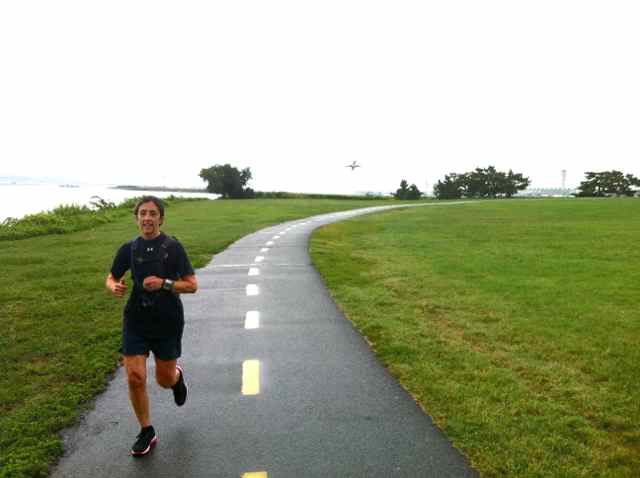 |
 | Farther up the trail we see the Capitol, the Jefferson Memorial, and the Washington Monument across the water, that last one clad in attractive scaffolding as repairs continue from the 2011 earthquake. Kate spots a fascinating stone sculpture by the trail, featuring gulls in flight and cresting waves. It's the Navy-Merchant Marine Memorial, and we pause again to take photos of it. At the end of the MVT near Teddy Roosevelt Island we reminisce about the turnaround of our Potomac Heritage trek (see again 2009-01-19 - PHT Valkyrie) and debate briefly whether to get another photo there, 4.5 years later. But not today — we continue on following the Custis Trail signs which lead us through Rosslyn, past where Kate remembers dropping from the 2012-10-28 - Marine Corps Marathon 2012 at mile 5 due to horrible back pain, since then greatly improved by surgery. As we proceed along the Custis Trail I remember long long ago (mid-1990s?) runs from Tina Chancey's home near here, when DS & DD were taking viola da gamba lessons. Back then a 1-2 mile trek was a lot. Kate and I laugh at how much one's standards get recalibrated over time. Kate recognizes a pair of young women who met us a couple of hours ago when we were outbound on Four Mile Run Trail. Apparently they're doing the loop in the clockwise direction. We greet them and salute. |
(Runkeeper and Garmin GPS concur to within a few percent)
- Friday, September 06, 2013 at 04:11:47 (EDT)
Eating Animals by Jonathan Safran Foer makes a powerful case for vegetarianism and against modern factory farming. The writing style is smooth, the stories of cruelty to animals are gruesome and graphic, and some of the arguments are convincing.
But Eating Animals is also frustratingly sloppy, repetitive, inconsistent, derivative, and fuzzy in its philosophical thinking. There's the feel, in the final chapter, that he was scooped and knows it:
The secrecy that has enabled the factory farm is breaking down. The three years I spent writing this book, for example, saw the first documentation that livestock contribute more to global warming than anything else; saw the first major research institution (the Pew Commission) recommend the total phaseout of multiple dominant intensive-confinement practices; saw the first state (Colorado) illegalize common factory farm practices (gestation and veal crates) as a result of negotiations with industry (rather than campaigns against industry); saw the first supermarket chain of any kind (Whole Foods) commit to a systematic and extensive program of animal welfare labeling; and saw the first major national newspaper (the New York Times) editorialize against factory farming as a whole, arguing that "animal husbandry has been turned into animal abuse," and "manure ... has been turned into toxic waste."
Foer means well, no doubt — but throwing personal anecdotes against a wall isn't the best way to make a rational argument. The three big issues that form his case are crucial:
Externalizing the social costs of modern agriculture makes meat prices artificially low and encourages massive waste in multiple dimensions. That's simple economics; everyone (except those immediately profiting) can likely agree that it needs fixing. The larger questions of animal rights and justice to fellow living creatures are important and deserve deep examination. Eating Animals doesn't provide that. It's a thin book, and could have done better.
And yes, it persuaded me to turn away from my daily egg sandwich. But that's not logic!
(cf. SufferTheAnimals (2000-06-11), CompassionateCarnivorism (2002-11-19), FeedOrFeedback (2004-09-06), Franklin on Vegetarianism (2008-06-17), Omnivore's Dilemma (2009-05-16), Philosophical Vegetarian Issues (2010-07-15), Milligan on Vegetarianism (2012-11-02), Grace To Be Said at the Supermarket (2013-01-08), ...)
- Thursday, September 05, 2013 at 04:31:15 (EDT)
A new linguistic term for the ^z scrapbook: hachek, also written haček. It's the name for the diacritical mark shaped like an inverted circumflex over a "c", making it "č" and indicating that the letter should be pronounced affricate, palatalized, iotated, or postalveolar — whatever that means! (Sounds pretty much like a "ch" to my tin ear.)
(cf. VoicedPostalveolarFricative (2003-09-27), ConfoundedConflation (2007-12-18), ...)
- Wednesday, September 04, 2013 at 04:30:46 (EDT)
Roger Zelazny's novels The Chronicles of Amber are fun fantasy from the 1970s, with sharp-edged swordplay, cross-time travel among universes, Tarot imagery, Chandleresquely noir banter, heavy smoking, excessive drinking, narrow glinting eyes, and on occasion strikingly lyrical passages. In Chapter 1 of Nine Princes in Amber, the first of the series, the protagonist awakens in a hospital, suffering from amnesia after an "accident" that clearly was no accident:
So I sat up. It took me a real effort, as my muscles were very tired. It was dark outside and a handful of stars were standing naked beyond the window. I winked back at them and threw my legs over the edge of the bed.
... and a few pages later, as he makes his escape by knocking out a guard:
I shoved him into the closet and looked out the latticed window. I saw the Old Moon with the New Moon in her arms, hovering above a row of poplars. The grass was silvery and sparkled. The night was bargaining weakly with the sun. Nothing to show, for me, where this place was located. ...
... followed in Chapter 2 with a sinister encounter:
Like all libraries, it was full of books. It also held three paintings, two indicating quiet landscapes and one a peaceful seascape. The floor was heavily carpeted in green. There was a big globe beside the big desk with Africa facing me and a wall-to-wall window behind it, eight stepladders of glass. But none of these was the reason I'd paused.
The woman behind the desk wore a wide-collared, V-necked dress of blue-green, had long hair and low bangs, all of a cross between sunset clouds and the outer edge of a candle flame in an otherwise dark room, and natural I somehow knew, and her eyes behind glasses I didn't think she needed were as blue as Lake Erie at three o'clock on a cloudless summer afternoon; and the color of her compressed smile matched her hair. But none these was the reason I'd paused.
I knew her, from somewhere, though I couldn't say where.
... and a page later, Our Hero continues his verbal fencing match in spite of being clueless as to who, or where, he is:
I drew on my cigarette, hoping she'd say something more. But she didn't, so I decided to seize what seemed the advantage I'd obtained in this game I didn't understand with players I didn't know for stakes I had no inkling of.
A clichéd beginning to a tale, sure — but charmingly well-done!
(cf. Lord of Light (2010-04-12), Science vs. Fantasy (2010-04-28), ...)
- Tuesday, September 03, 2013 at 21:00:25 (EDT)
For back issues of the ^zhurnal see Volumes v.01 (April-May 1999), v.02 (May-July 1999), v.03 (July-September 1999), v.04 (September-November 1999), v.05 (November 1999 - January 2000), v.06 (January-March 2000), v.07 (March-May 2000), v.08 (May-June 2000), v.09 (June-July 2000), v.10 (August-October 2000), v.11 (October-December 2000), v.12 (December 2000 - February 2001), v.13 (February-April 2001), v.14 (April-June 2001), 0.15 (June-August 2001), 0.16 (August-September 2001), 0.17 (September-November 2001), 0.18 (November-December 2001), 0.19 (December 2001 - February 2002), 0.20 (February-April 2002), 0.21 (April-May 2002), 0.22 (May-July 2002), 0.23 (July-September 2002), 0.24 (September-October 2002), 0.25 (October-November 2002), 0.26 (November 2002 - January 2003), 0.27 (January-February 2003), 0.28 (February-April 2003), 0.29 (April-June 2003), 0.30 (June-July 2003), 0.31 (July-September 2003), 0.32 (September-October 2003), 0.33 (October-November 2003), 0.34 (November 2003 - January 2004), 0.35 (January-February 2004), 0.36 (February-March 2004), 0.37 (March-April 2004), 0.38 (April-June 2004), 0.39 (June-July 2004), 0.40 (July-August 2004), 0.41 (August-September 2004), 0.42 (September-November 2004), 0.43 (November-December 2004), 0.44 (December 2004 - February 2005), 0.45 (February-March 2005), 0.46 (March-May 2005), 0.47 (May-June 2005), 0.48 (June-August 2005), 0.49 (August-September 2005), 0.50 (September-November 2005), 0.51 (November 2005 - January 2006), 0.52 (January-February 2006), 0.53 (February-April 2006), 0.54 (April-June 2006), 0.55 (June-July 2006), 0.56 (July-September 2006), 0.57 (September-November 2006), 0.58 (November-December 2006), 0.59 (December 2006 - February 2007), 0.60 (February-May 2007), 0.61 (April-May 2007), 0.62 (May-July 2007), 0.63 (July-September 2007), 0.64 (September-November 2007), 0.65 (November 2007 - January 2008), 0.66 (January-March 2008), 0.67 (March-April 2008), 0.68 (April-June 2008), 0.69 (July-August 2008), 0.70 (August-September 2008), 0.71 (September-October 2008), 0.72 (October-November 2008), 0.73 (November 2008 - January 2009), 0.74 (January-February 2009), 0.75 (February-April 2009), 0.76 (April-June 2009), 0.77 (June-August 2009), 0.78 (August-September 2009), 0.79 (September-November 2009), 0.80 (November-December 2009), 0.81 (December 2009 - February 2010), 0.82 (February-April 2010), 0.83 (April-May 2010), 0.84 (May-July 2010), 0.85 (July-September 2010), 0.86 (September-October 2010), 0.87 (October-December 2010), 0.88 (December 2010 - February 2011), 0.89 (February-April 2011), 0.90 (April-June 2011), 0.91 (June-August 2011), 0.92 (August-October 2011), 0.93 (October-December 2011), 0.94 (December 2011-January 2012), 0.95 (January-March 2012), 0.96 (March-April 2012), 0.97 (April-June 2012), 0.98 (June-September 2012), 0.99 (September-November 2012), 0.9901 (November-December 2012), 0.9902 (December 2012-February 2013), 0.9903 (February-March 2013), 0.9904 (March-May 2013), 0.9905 (May-July 2013), 0.9906 (July-September 2013), 0.9907 (September-October 2013), 0.9908 (October-December 2013), 0.9909 (December 2013-February 2014), 0.9910 (February-May 2014), 0.9911 (May-July 2014), 0.9912 (July-August 2014), ... Current Volume. Send comments and suggestions to z (at) his.com. Thank you! (Copyright © 1999-2014 by Mark Zimmermann.)